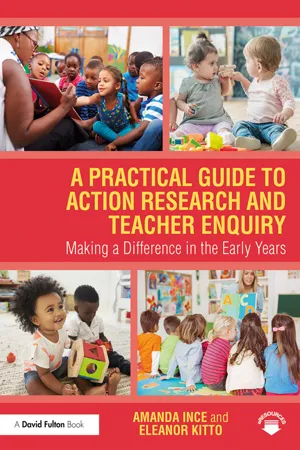
A Practical Guide to Action Research and Teacher Enquiry
Making a Difference in the Early Years
- 98 pages
- English
- ePUB (mobile friendly)
- Available on iOS & Android
A Practical Guide to Action Research and Teacher Enquiry
Making a Difference in the Early Years
About this book
This accessible guide will be an invaluable resource for early years practitioners looking to make a positive difference in their settings by using action research or teacher enquiry. Guiding readers through the practical steps, issues, and potentials of conducting research in a variety of early childhood settings, the book will increase practitioners' confidence, enabling them to bridge the gap between recognising room for improvements and instigating necessary changes.
Divided into easy-to-follow sections, A Practical Guide to Action Research and Teacher Enquiry: Making a Difference in the Early Years offers clear definitions and explanations of action research along with explanations of how it can be applied in early years settings to effectively and efficiently improve outcomes for children. Chapters outline a clear rationale for engaging in action research, highlight purposes and potentials of various approaches, and provide a helpful step-by-step discussion of the different stages of enquiry. Ten examples of practice are used to clearly illustrate the action research cycle in a variety of settings, and in relation to a range of topics and ages, thereby providing readers with a wealth of tried-and-tested ideas for application in their own settings and projects. These are supported by a range of downloadable resources which can be used as tools to support the planning, reflecting, and evaluation of practitioners' research activities.
Informative, inspiring, and highly relevant to practice, A Practical Guide to Action Research and Teacher Enquiry will support and scaffold the research activities of early years practitioners, managers, and students.
Frequently asked questions
- Essential is ideal for learners and professionals who enjoy exploring a wide range of subjects. Access the Essential Library with 800,000+ trusted titles and best-sellers across business, personal growth, and the humanities. Includes unlimited reading time and Standard Read Aloud voice.
- Complete: Perfect for advanced learners and researchers needing full, unrestricted access. Unlock 1.4M+ books across hundreds of subjects, including academic and specialized titles. The Complete Plan also includes advanced features like Premium Read Aloud and Research Assistant.
Please note we cannot support devices running on iOS 13 and Android 7 or earlier. Learn more about using the app.
Information


Table of contents
- Cover
- Half Title
- Title
- Copyright
- Contents
- Acknowledgements
- Foreword by Dr. Guy Roberts-Holmes
- Introduction
- Part one: Action research: Theory and practice
- Part two: The phases of action research
- Part three: The projects
- Conclusion
- References
- Appendices
- Index